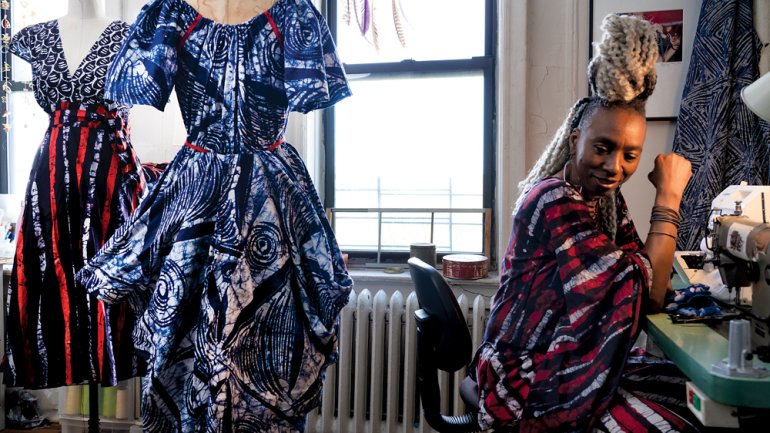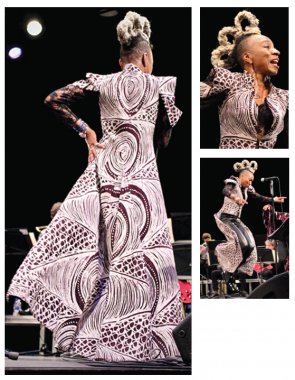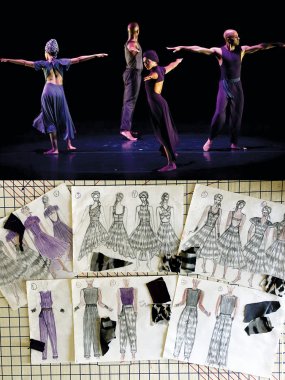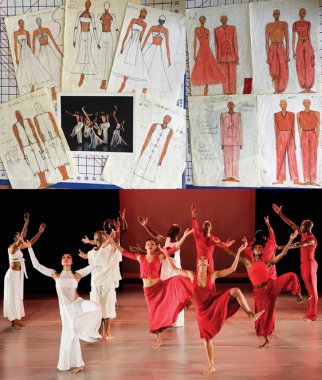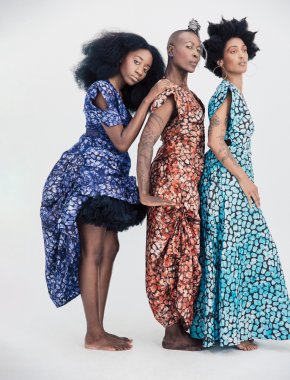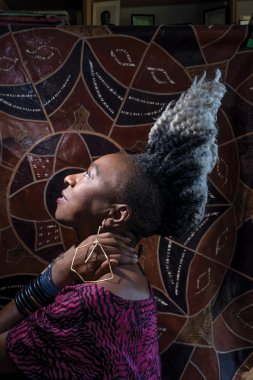Made to Move
Made to Move
In Grace, a story of the spiritual journey of individuals to the promised land, an angelic figure, the mother goddess, takes center stage in white flowing fabric. Her bandeau top has a chiffon overlay that serves as a kind of shield, even as it reminds us of lingerie. A dozen other dancers, clad in loose white pants made fluid with motion, move opposite earthly opponents clad in fire red. Grace is one of the most popular works in the repertory of the Alvin Ailey American Dance Theater. Much of the power of the performance, which was commissioned in 1999, comes from the choreography of Ronald K. Brown, a soundtrack that includes Fela Kuti’s “Shakara” and Duke Ellington’s “Come Sunday,” and the expertise of the dancers. But the costumes are equally potent in telling the story.
The costumes are the work of Ibiwunmi Omotayo Olaiya, better known as Wunmi, a singer, songwriter, performer, and fashion designer. Born in London and raised in Lagos, Nigeria, the 54-year-old, who now lives in Brooklyn, sees dress and style as integral to identity. From an early age, she learned the transformative power of art, be it music, dance, or dress. “My parents were working and living in London, so I grew up with my nan [grandmother] in Lagos, but very much on my own,” she remembers. “I created my own world of pretend, of dress-up. I was dressing my own love and need. This became a way of being.” That ethos – of clothing as a crucial element of sound, of movement, and of life – has remained a constant in her creative career.
At 14, Wunmi returned to London to live with her dad, who ran a pretty strict household. She found her creative outlet in dance and style. “Dressing was a way to create my own identity,” she says. “I wore weird, different outfits, and I sewed my own clothes.” At the time, she didn’t think of pursuing design professionally – “I was creating myself” she says – but teachers took notice of her talents and persuaded her to attend the London College of Fashion.
While in college in the 1980s, Wunmi started her first fashion line, Revolution With Love, with her best friend Donovan Pascal. The line featured one-of-a-kind jackets made from prayer rugs. Adopting unusual materials would come to define her design aesthetic, and the label reaffirmed her individualism with its slogan “This is me.” At the same time, she was performing as a singer and dancer with the exploding UK house-music scene, wearing her own uniquely styled and tailored outfits. She danced with the band Soul II Soul and was featured as a silhouette in the video for the 1989 hit “Back to Life.” The success brought another dramatic change; when the band went to New York City that year, she went along.
In New York, Wunmi’s music was heavily influenced by Afrobeat and particularly by Fela Kuti, a pioneer in the genre. Wunmi helped introduce those elements to the city’s sound. Popular musicians began sampling her demos, and she became a fixture in the creative community. Her design work dovetailed with the music; she started working with influential choreographers and dance companies. Marlies Yearby, choreographer for Rent, became a mentor and introduced her to Brown, who offered Wunmi a place to stay in exchange for designing costumes for his dance company, Evidence.
Thus began a collaboration that has continued for more than 20 years. In addition to Grace, Wunmi has designed for the sequel Serving Nia (2001); Dancing Spirit (2009), Brown’s tribute to Ailey dancer and artistic director Judith Jamison; and Four Corners (2013), a story of four angels holding the four winds. She shapes her style to the demands of the performance. For Four Corners, “Ron situated the dance in that pre-dawn time where it’s an early-morning haze,” Wunmi says, so she created custom-dyed fabrics in rich purples, deep grays, and black.
Wunmi’s latest collaboration is with six-time Grammy winner Arturo O’Farrill & the Afro Latin Jazz Orchestra. As part of a four-month artist-in-residence program at the Greene Space in New York City, O’Farrill and his band paid tribute to Fela Kuti, with Wunmi featured as a guest artist. In addition to performing, she designed the costumes – taking oceanic inspiration, fish scales and deep, rich hues – for the entire band and for her backup singers. What might have been a stressful undertaking was, for Wunmi, a relief. “I didn’t know what my girls would wear until the day of the show,” she says, “but sewing calms my nerves.”
In 2012, Wunmi started another apparel line called Wow Wow. The clothes are primarily made in Nigeria, where she works closely with textile artisans and tailors to create heirloom-quality pieces for men, women, and children, providing mentorship, jobs, and new markets for the community. As ever, Wunmi had performance in mind. “The same things I created on stage were lived off stage,” she says. “My fellow dancers asked for my creations, and a collection was formed.” The name has layered meaning. It refers to waaw in the Wolof language, meaning “yes-yes” and also translates as the motto for the line “want it – own it – wear it, Wunmi Olaiya Wear.”
Empowering women and celebrating the individual are key components of the brand. “Every family event in Nigeria was something to celebrate. Women dress uniformly as a way to express solidarity,” Wunmi notes. “However, I want women to express their individuality in Wow Wow. … Owning a piece of Wow shares that vibrancy. It’s your version of your personal ‘wow.’ ” The company creates cloth using adire, a resist-dyeing technique primarily from Nigeria (Wunmi’s design aesthetic is a fusion of Japanese and African, she says) while the colors – bright hues often mixed with indigo – recall the fruits and textile patterns of an African market.
Wunmi’s current project revisits Brown’s Grace for its 20th anniversary presentation and includes a new complementary dance, Mercy. For the latter piece, Brown collaborated with a range of musicians, including bassist and singer Meshell Ndegeocello, to perform Ndegeocello’s original score.
Wunmi called on science fiction and Afropunk for her designs, turning to Octavia Butler’s novels Kindred and Wild Seed for inspiration. The novels have prompted questions that can be read as the guiding principles of Wunmi’s creative life: “Where did we come from? Where do we go from here? What will we make of the new space?”
As for the future, Wunmi aspires to extend her collaborations beyond choreographers and musicians to artisans from a variety of practices including furniture and interior design, green accessories, and architecture. Her goal is to build on what was once perceived as “local” craft to grow Wow Wow into a global brand.


